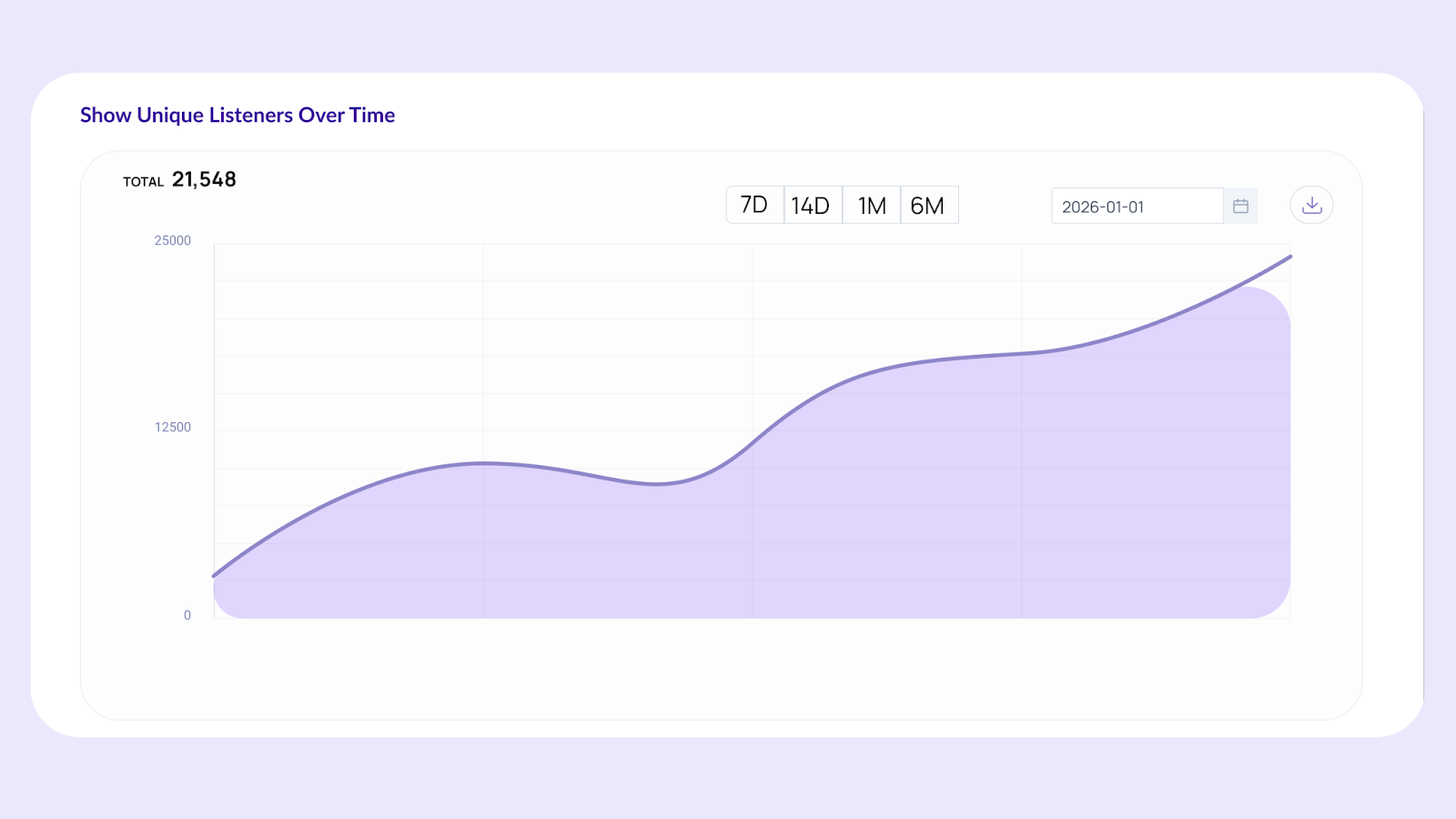You’re likely familiar with customer churn, retention, and acquisition.
Churn means customers stop using your products or services, retention means existing customers continue using your products or services, and acquisition means new customers start using your products or services.
Churn and retention are also incredibly valuable metrics within a podcasting context. Podcasts will see both listener churn, retention, and, of course, acquisition.
- Listener churn: When existing listeners stop listening to your podcast.
- Listener retention: When existing listeners continue listening to your podcast.
- Listener acquisition: When new listeners start listening to your podcast.
Pretty simple, right?
Well, the challenge comes from not understanding what listener churn, retention, and acquisition mean, but rather, how to effectively measure them.
But luckily, that’s exactly what we’re going to be diving into within this article. So let’s get into it.
Why measuring podcast churn, retention, & acquisition matters
Let’s start at the beginning.
Why does measuring podcast churn, retention, and acquisition even matter?
As a data nerd myself, having these insights provides a robust look at your podcast’s health.
Let’s break them down:
- Listener acquisition: Signals if new listeners are discovering your show, whether marketing campaigns are effective or not, and if you're sustainably scaling your content.
- Listener retention: Measures loyalty but understanding if listeners are sticking around, but also tells you whether your content is resonating and relevant to audiences.
- Listener churn: Warns you of content misalignment with your target audience or event content fatigue.
How to measure podcast churn, retention, & acquisition
Measuring podcast acquisition
First, let’s take a look at how to measure when new listeners are coming to your podcast.
This was an ongoing problem that many of our users were having with their podcasts. Measuring net new listeners featured a lot of guesstimating by using unique listener dashboards and cross-referencing with downloads dashboards.
But for us, that just wasn’t good enough.
We recently launched CoHost’s New Listener Metric, which quantifies audience acquisition over customizable time periods.
Using the New Listener Metric, you can measure the following:
- Track net new listeners: Measure how many new listeners your show is bringing in over a desired time period.
- See which episodes brought in new listeners: Although this metric doesn’t break out episode-level performance, after you release episodes, explore how many new listeners you’ve acquired within the first weeks of launch.
- Spot patterns in marketing campaign performance: After launching marketing campaigns, review new listeners to see how many you’ve acquired during the campaign period. Compare these numbers to the previous period to track listener growth from campaigns.

We’re still gathering what common benchmarks for this new metric are. Sign up for our bi-weekly newsletter to stay informed on upcoming reports.
Measuring podcast retention
There are two ways you can go about measuring podcast retention:
- The first is by looking at unique listeners at a show and episode level.
- The second is by looking at the consumption rate at a show and episode level.
Let’s chat about unique listeners first:
Measuring podcast retention with unique listeners
Unlike downloads, which count every play, unique listeners track how many individuals tuned in. For example, if I listen to your episode three times, that counts as three downloads but one unique listener.
Because of this, unique listeners are helpful metrics to measure reach and, of course, retention.
To measure retention:
- Track your average unique listeners per episode. If you consistently see ~500 per episode, that’s a strong indicator of your core, returning audience.
- You can also layer in CoHost’s New Listener Metric (mentioned above) to separate new vs. returning listeners. Subtract new listeners from total unique listeners over a set period (7, 14, 30 days, etc.) to estimate your retained audience.

For example:
- Week 1: You have 500 unique listeners and 100 new listeners.
- Week 2: You have 640 unique listeners and 60 new listeners.
If you subtract your new listeners from Week 2 (640-60), you get 580 unique listeners for Week 2. That’s 80 more unique listeners than you had in Week 1. You might infer that 80 of those 100 new listeners stuck around from Week 1, giving you an 80% retention rate.
While not exact, this gives directional insight into listener loyalty and growth trends.
Within CoHost, you can explore the following unique listener data:
- Unique listeners in the last 7 days, 14 days, 30 days, and all-time.
- Unique listeners over time in a line graph format.
- Unique listeners by episode release comparisons (select up to five episodes).
- Unique listeners by complete episode breakdown.
Measuring podcast retention with consumption data
Another route you can take to measure retention is through consumption data.
Consumption rates and listen times tell you how much or long of an episode audiences are tuning in for.
For example, if your consumption rate is 90%, then that’s amazing, it means that your listeners are retaining for the majority of the episode. But if it’s something like 50%, that’s a signal that either you need to take a look at your content, format, guests, or there’s misalignment with your target audience.
We typically recommend aiming for a consumption rate of 75-80%.

On CoHost, we provide the following consumption metrics:
- Episode consumption rate from Apple, Spotify, and a weighted average between the two.
- Episode listen time from Apple, Spotify, and a weighted average between the two.
- An overall show consumption rate from Apple.
Measuring podcast churn
Churn happens when existing listeners stop tuning in. While some churn is natural, consistent declines in engagement can signal deeper issues with content, audience fit, or distribution.
To measure churn, track unique listeners over time:
- Compare unique listeners from a previous period (e.g., last week) to the current one.
- A consistent downward trend indicates audience churn.
For example, if you notice that week over week, you’re losing an average of 10 unique listeners, you’re likely experiencing podcast audience churn.
CoHost’s Unique Listeners Over Time chart is a simple way to view the growth or decline of your unique listeners across your desired timeline.

Some early signs of listener churn can be:
- Drop in unique listeners even as new listeners come in.
- Lower consumption rates.
- Decreasing feedback or listener interactions.
Best practices to boost acquisition, retention & reduce churn
For podcast listener acquisition:
There’s no set playbook on how to grow your podcast audience. But leveraging a mix of paid, owned, and earned tactics is going to help set your show up for success.
Some we commonly recommend are:
- Guesting on other relevant shows.
- Cross-promoting with partners or collaborators.
- Repurpose episodes into blogs, social media posts, newsletters, etc.
- Advertising on podcast-specific platforms like PlayerFM, Podroll, or the Listen Network.
For podcast listener retention:
To retain existing audiences, you want to keep providing them consistent value, ensuring they continue coming back for more.
Tactics may look like:
- Delivering consistent content on a set publishing cadence.
- Updating episode structure and content to fit listener needs.
- Improving narrative flow and reducing filler content over time.
- Talking to your audience via surveys, reviews, or social media to ensure you’re listening and implementing their feedback.
For podcast listener churn:
And finally, to reduce podcast audience churn to the best of your ability, we recommend the following steps:
- Keeping content, guests, and topics fresh to avoid episode fatigue.
- Using podcast analytics to understand what content your audience resonates with,
- Reviewing listener feedback and drop-off patterns to identify areas for improvement,
Sustainable podcast growth starts with smarter measurement
Growing a podcast isn’t about chasing virality; it’s about building something your audience wants to return to, week after week.
That kind of podcast growth doesn’t come from guesswork. It comes from understanding who’s tuning in, who’s dropping off, and what’s actually moving the needle.
And, of course, this knowledge is a product of measurement. Combine insights from listener acquisition, retention, and churn to build a full picture of your show’s health. Then, use those insights to shape smarter content, stronger campaigns, and more connected experiences across your brand and podcast.
To learn more about CoHost’s podcast analytics, chat with our team and to stay up to date on all the latest happenings in the podcast industry, including tips, advice, and research, subscribe to Tuned In.










